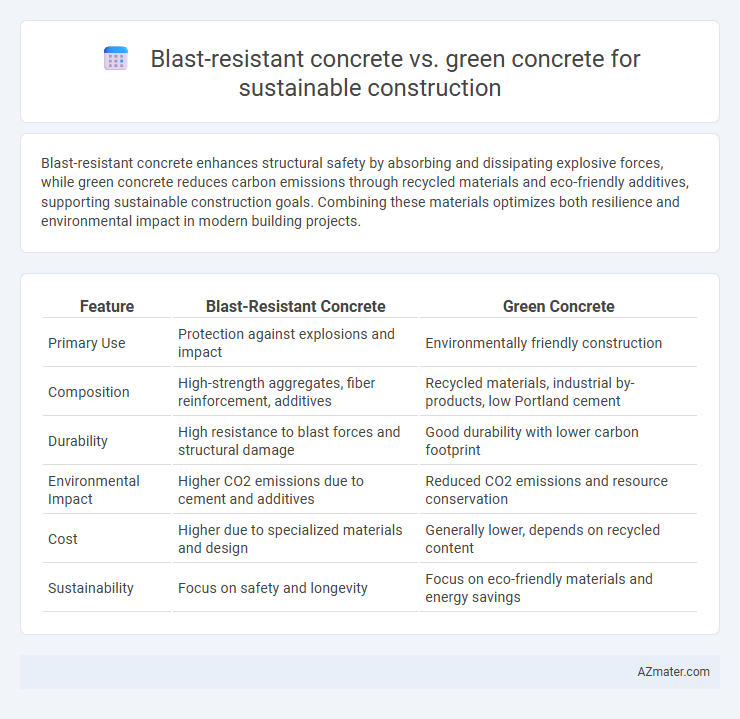Blast-resistant concrete enhances structural safety by absorbing and dissipating explosive forces, while green concrete reduces carbon emissions through recycled materials and eco-friendly additives, supporting sustainable construction goals. Combining these materials optimizes both resilience and environmental impact in modern building projects.
Table of Comparison
| Feature | Blast-Resistant Concrete | Green Concrete |
|---|---|---|
| Primary Use | Protection against explosions and impact | Environmentally friendly construction |
| Composition | High-strength aggregates, fiber reinforcement, additives | Recycled materials, industrial by-products, low Portland cement |
| Durability | High resistance to blast forces and structural damage | Good durability with lower carbon footprint |
| Environmental Impact | Higher CO2 emissions due to cement and additives | Reduced CO2 emissions and resource conservation |
| Cost | Higher due to specialized materials and design | Generally lower, depends on recycled content |
| Sustainability | Focus on safety and longevity | Focus on eco-friendly materials and energy savings |
Introduction to Sustainable Concrete Solutions
Blast-resistant concrete enhances structural safety by incorporating high-strength aggregates and fiber reinforcements to withstand explosive impacts, making it ideal for critical infrastructure. Green concrete reduces environmental impact through the use of recycled materials, industrial by-products like fly ash and slag, and lower cement content, significantly cutting CO2 emissions. Both solutions contribute to sustainable construction by improving durability and environmental performance, aligning with global goals for resilient and eco-friendly building practices.
Defining Blast-Resistant Concrete
Blast-resistant concrete is engineered to withstand high-impact forces and explosive loads, incorporating advanced materials like fiber reinforcement and high-strength aggregates to enhance durability and structural integrity. It is designed to absorb and dissipate energy from blasts, minimizing structural damage and ensuring safety in critical infrastructure such as military buildings, transportation hubs, and industrial facilities. Unlike green concrete, which focuses on reducing environmental impact through recycled materials and lower carbon emissions, blast-resistant concrete prioritizes performance under extreme conditions while still allowing integration of sustainable components.
Understanding Green Concrete Technologies
Green concrete technologies use industrial by-products like fly ash, slag, and recycled aggregates to reduce carbon emissions and conserve natural resources, making it an eco-friendly alternative to conventional blast-resistant concrete. While blast-resistant concrete emphasizes strength and durability to withstand explosive forces, green concrete integrates sustainable materials and innovative curing processes to enhance environmental performance without compromising structural integrity. Employing green concrete in sustainable construction supports energy efficiency, reduces greenhouse gas emissions, and promotes circular economy principles compared to traditional high-strength blends.
Key Materials and Composition Differences
Blast-resistant concrete incorporates high-strength aggregates such as quartz, basalt, or steel fibers combined with polymer additives to enhance impact resistance and energy absorption under explosive loads. Green concrete emphasizes the use of supplementary cementitious materials like fly ash, slag, and recycled aggregates to reduce carbon footprint and promote eco-friendly construction practices. The key distinction lies in blast-resistant concrete's focus on mechanical performance, while green concrete prioritizes sustainability through material recyclability and lower embodied energy.
Performance in Extreme Conditions
Blast-resistant concrete exhibits superior performance in extreme conditions by providing enhanced structural integrity and energy absorption during explosive impacts, making it ideal for critical infrastructure in hazardous environments. Green concrete, formulated with recycled materials and low carbon footprint binders, offers sustainability benefits while maintaining adequate durability and resistance against environmental stressors such as high temperatures and chemical exposure. Combining the resilience of blast-resistant concrete with the eco-friendly properties of green concrete advances sustainable construction practices without compromising safety and performance under extreme conditions.
Environmental Impact Comparison
Blast-resistant concrete incorporates specialized aggregates and fibers that enhance structural durability, reducing the need for frequent repairs and resource consumption. Green concrete utilizes industrial by-products like fly ash and slag, significantly lowering carbon dioxide emissions and minimizing natural resource depletion. Comparing environmental impacts, green concrete offers superior sustainability advantages by reducing greenhouse gas emissions, while blast-resistant concrete extends building lifespan, indirectly supporting resource conservation.
Cost Analysis and Economic Viability
Blast-resistant concrete typically incurs higher initial costs due to specialized materials and manufacturing processes, but it enhances safety and reduces potential damage-related expenses in high-risk environments. Green concrete, made with recycled materials and sustainable practices, offers improved cost-efficiency over time by lowering energy consumption and reducing carbon footprint without compromising structural integrity. Evaluating long-term economic viability requires balancing upfront investment in blast resistance against the environmental and operational savings provided by green concrete solutions.
Applications in Modern Sustainable Construction
Blast-resistant concrete provides enhanced safety and durability in infrastructure exposed to high-impact forces, making it ideal for military buildings, transportation hubs, and critical facilities. Green concrete promotes sustainability by incorporating recycled materials and reducing carbon emissions, suitable for residential and commercial developments aiming for LEED certification. Both materials contribute uniquely to modern sustainable construction by balancing resilience and environmental responsibility in various applications.
Innovations and Future Trends
Blast-resistant concrete incorporates advanced additives like ultra-high-performance fibers and nanomaterials to enhance energy absorption and structural resilience against explosions. Green concrete focuses on low-carbon alternatives such as geopolymer binders, recycled aggregates, and biogenic materials to reduce environmental impact and promote sustainability. Future trends involve integrating smart sensing technologies with both concretes to monitor real-time performance and optimize lifecycle durability in sustainable construction projects.
Conclusion: Balancing Strength and Sustainability
Blast-resistant concrete provides unparalleled durability and safety in high-impact scenarios, essential for critical infrastructure, while green concrete offers significant reductions in carbon footprint through recycled materials and lower energy consumption. Balancing these materials in sustainable construction projects requires optimizing structural performance without compromising environmental goals. Integrating innovative mix designs can achieve both enhanced blast resistance and sustainability, promoting resilient and eco-friendly built environments.

Infographic: Blast-resistant concrete vs Green concrete for Sustainable construction
 azmater.com
azmater.com